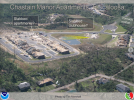You can see it in one of the satellite images
@joshoctober16 shared but here's another pic I found. One of them was thrown 100 feet uphill:
View attachment 34650
Pretty impressive considering they were 100 feet tall, weighed 68,000 pounds, and were anchored to concrete footers (which were damaged beyond repair)! Here's a picture of the coal train that was tossed.
View attachment 34651
"One car, which weighed 36 tons, was hurled 120 yards (visible at center). Eyewtiness statements suggest the car was thrown in one toss and not rolled (Knupp et al., 2012).
This is the longest distance a railroad car has ever been moved by a tornado and possible evidence of EF5 winds."
This study by Iowa State determined it could've been done by 145 MPH winds, but I think they took some pretty huge leaps in logic to reach that conclusion.
Here's Tim Marshall and Jim Ladue's explanation on the rating for the Chastain Manor Apartments and Clubhouse:
View attachment 34652
View attachment 34653
View attachment 34654
This slide fails to mention that the building’s second floor was at ground level on the uphill side of the complex and was swept cleanly away to its
cement floor. The structural anchorage was to code, but not considered “superior” in quality.
Here's the Clubhouse explanation
View attachment 34655
Three members from the National Science Foundation (NSF) rated it EF5 due to
1. Slab swept clean indicates greater than
DOD=6.
2. Nail spacing to code (6" OC)
3. Quality Southern Pine, large shearwalls
4. Similar construction to houses where a higher
DOD is available
View attachment 34657
Seems pretty wild that this is considered "too much debris around", considering most of it is completely gone (maybe in the pond?), but what do I know....















































